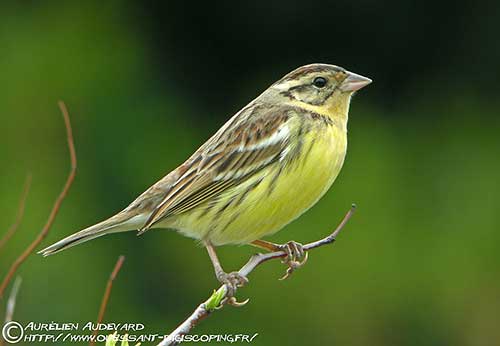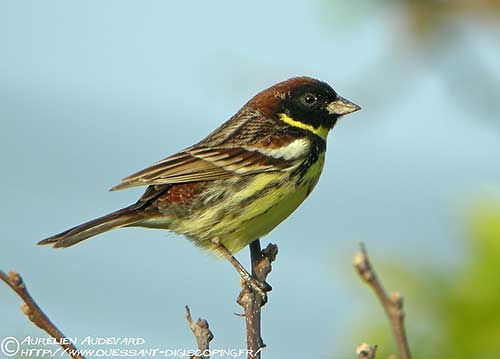
PROTECTION / THREATS / STATUS:
The population of the Yellow-breasted Bunting is declining rapidly, due to trapping and hunting during migration, and especially on the wintering grounds.
The flocks roosting in reedbeds are disturbed and the birds are caught in mist-nets. They are cooked and sold as sparrows or rice-birds in a small area of Southern China. But this practice has become more widespread, and several thousand individuals were caught for food festival. Finally, this practice was banned in 1997. However, a black market in birds still persists and a huge number of birds are sold every year, around 10,000 birds per day.
The species remains a delicacy in S China, Cambodia and Nepal. In addition, thousands of males are sold as mascots, because their presence may confer happiness.
Degradation and modification of the habitat involve declines both on breeding and wintering grounds. Use of pesticides and changes in agricultural practices since the 1980s in Nepal also caused declines.
The European breeding population was estimated to number 60,000/300,000 individuals in 2004, and Europe formed 25/49% of the global range. Today, the European population is estimated at 120/300 mature individuals (2015).
The Yellow-breasted Bunting is currently listed as Critically Endangered, and the species needs conservation actions.
Fr: Bruant auréole
Ang: Yellow-breasted Bunting
All: Weidenammer
Esp: Escribano Aureolado
Ita: Zigolo dal collare
Nd: Wilgengors
Sd: gyllensparv
Photographers:
John Anderson
John Anderson Photo Galleries
Aurélien Audevard
OUESSANT DIGISCOPING
Didier Buysse
Vision d’Oiseaux
Text by Nicole Bouglouan
Sources:
HANDBOOK OF THE BIRDS OF THE WORLD Vol 16 by Josep del Hoyo- Andrew Elliot-David Christie – Lynx Edicions – ISBN: 9788496553781
THE HANDBOOK OF BIRD IDENTIFICATION FOR EUROPE AND THE WESTERN PALEARCTIC by Mark Beaman, Steve Madge - C. Helm - ISBN: 0713639601
A Field Guide to the Birds of South-East Asia by Craig Robson. New Holland Publishers. ISBN: 9781780090498
Buntings and Sparrows Par Clive Byers, Urban Olsson, Jon Curson – Editeur: A&C Black, 2013 – ISBN: 1408189062, 9781408189061 – 264 pages
BirdsRussia – Save birds for future generations
World Migratory Bird Day (WMBD)
What Bird-The ultimate Bird Guide (Mitchell Waite)
South Dakota Birds and Birding – (Terry L. Sohl)
Wikipedia, the free encyclopaedia
Yellow-breasted Bunting
Emberiza aureola
Passeriformes Order – Emberizidae Family
INTRODUCTION:
The Yellow-breasted Bunting is a species of the family Emberizidae. It breeds in a large northern part of Eurasia and winters in S and SE Asia and Indian Subcontinent. Two subspecies share the wide range.
This species is now absent from Eastern Europe, and it is local and uncommon on W of the range. It was commonly found as far away as Finland, but it has disappeared from Europe and the northern parts of Siberia and Japan.
The decline of this species was caused by illegal trapping and hunting on the wintering grounds. It is sold for human consumption in parts of China and SE Asia where it is eaten as a delicacy.
The Yellow-breasted Bunting breeds in grassy meadows with scattered trees and bushes, near marshes or rivers. During winter, it frequents cultivated areas, rice fields, reedbeds, scrub and gardens. It feeds on invertebrates, seeds and various plant materials according to the season.
The nest is on the ground in a depression protected by tussock or roots, but it is sometimes built slightly above the ground in the dense vegetation.
The Yellow-breasted Bunting declined by 80% within ten years, due to overharvesting on the wintering grounds. The species is now close to extinction and classified as Critically Endangered.
The Yellow-breasted Bunting was described in 1773 in W Siberia by Peter Simon Pallas (1741-1811), a Prussian zoologist and botanist who worked in Russia.
DESCRIPTION OF THE BIRD:
Biometrics:
Length: 14-15 cm
Wingspan: 23 cm
Weight: 14-33 g
The Yellow-breasted Bunting male in breeding plumage has brown-chestnut crown, upperparts and breast band. The flanks are streaked blackish. The black face and the upper throat contrast strongly with the bright yellow underparts. The lower throat is yellow, and this colour extends across the neck sides as a band, and contrasts with the dark breast band.
On the upperwing, we can see a conspicuous white shoulder patch and a narrow white wingbar on the wing-coverts, both well visible in flight. The flight-feathers are brown with narrow pale edges. The tail is dark brown but the outer rectrices have white outer webs.
The two-tone bill has dark grey upper mandible whereas cutting edge and lower mandible are pink. The eyes are dark chestnut-brown. Legs and feet are pinkish.

The non-breeding male is fairly similar but the head feathers have pale edges, lores are buffish, supercilium and centre of ear-coverts are yellow.
On the upperparts, the feathers have broader pale fringes. Chin, throat and malar area are yellow. The breast band is less conspicuous, with buffish fringes to feathers.
The breeding female resembles first winter male but her plumage appears worn and bleached. On the wings, the wingbars are narrower and duller. The breast band is usually absent.
The non-breeding female has warmer brown tones than the first winter male.
The juvenile resembles breeding female but the plumage appears very fresh. The breast is heavily streaked. The eyes are dark grey-brown.
The first winter male resembles non-breeding adult with less chestnut-brown tones. The breast band is replaced by diffuse streaking.
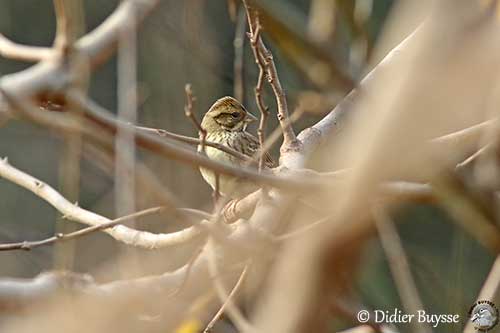
SUBSPECIES AND RANGE:
The Yellow-breasted Bunting has two subspecies.
E.a. aureola breeds in W Russia E to R Kolyma, S to N Ukraine, N Kazakhstan, and W and C Mongolia, and formerly E Finland. It winters in S and SE Asia.
E.a. ornata breeds in E Transbaikalia, NE Mongolia and NE China, E to Anadyr land, Kamchatka, Sea of Okhotsk coast, Sakhalin, and N Japan and Kuril Islands. It winters in N Indian Subcontinent, S China and SE Asia.
This race resembles nominate but it is darker, with brighter yellow on the underparts, and more extensive black on forecrown.
HABITAT:
The Yellow-breasted Bunting breeds in both wet and dry meadows with some trees such as willow, birch and alder, bushes, and tall herbaceous vegetation and scattered scrubs. It also frequents thickets along marshes and rivers, clearings in forest and edges of birch woodland.
During migration and winter, it is mostly found in a variety of habitats such as cultivated areas, grasslands and wetlands. It also frequents rice fields, giving the birds its other name in China “Rice Bird”.
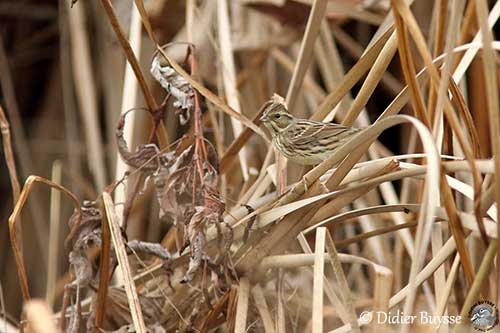
CALLS AND SONGS: SOUNDS BY XENO-CANTO
The Yellow-breasted Bunting’s usual call is a short, metallic “tsik” similar to the call of the European Robin. On the breeding grounds, it gives an abrupt “chup” when flushed.
The song by male is given from bush tops in wet meadows, and usually from tree tops. This song may vary according to individuals.
It is described as a far-carrying, monotonous, rising jingle of clear, ringing notes falling at the end “do-do-dee-dee-do-de” or “tru-tru-tree-tree-tri-tri-iih-tiu”.
BEHAVIOUR IN THE WILD:
The Yellow-breasted Bunting feeds mainly on a variety of invertebrates during the breeding season, including insects, spiders and snails. But it also takes seeds and plant materials, wheat, rice, bamboo and others, depending on the season.
It forages in low herbs and grass, flying up into bushes or low perches when disturbed. It rarely feeds on the bare ground.
Outside of breeding season, they forage in flocks.
This species is highly sociable and several pairs can settle close to each other at breeding sites. They gather in large concentrations in meadows and fields during migration and winter. Large flocks roost communally in bushes at night.
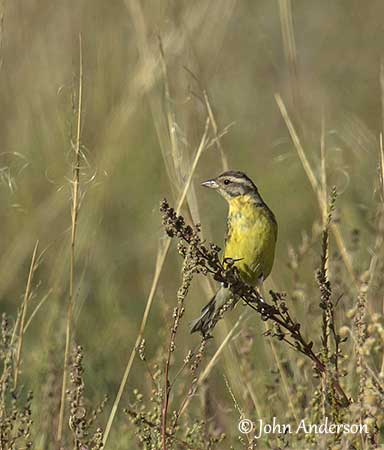
The Yellow-breasted Bunting nests on the ground in a depression protected by tussock or roots, and sometimes in willow or shrub or dense vegetation.
This species migrates along a relatively narrow corridor, flying through China and spending the winter in SE Asia. The birds from W populations fly to China to the east, whereas the birds of E populations fly to the west.
The flight is swift with rapid wingbeats interspersed with brief periods of wings pulled to sides.
REPRODUCTION OF THIS SPECIES:
The breeding season starts from mid-June to early July. This species produces a single brood per season, rarely two.
The female builds the nest on the ground, in a depression under vegetation, tussock or roots. It is made with dry grass and stalks, and lined with softer grass, rootlets and sometimes animal hair. But sometimes, the nest is built slightly above the ground in willow or shrub, always protected by vegetation.
She lays 4-5 greyish to greenish eggs with darker markings. Both adults share the incubation during 13-14 days, but the female does most of the work because she has a brood patch which is lacking in male.
The young leave the nest 11-14 days after hatching, before to be able to fly. They are independent one or two weeks later.
